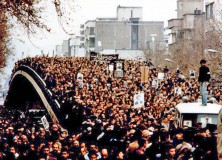Losing Iran: The Accidental Abandonment of an Ally through Interagency Failure — Jesse Paul Lehrke

INTRODUCTION:
From the end of the Second World War until the Revolution of 1978/79, Iran was a key American ally in the Middle East, serving as a counter to Soviet influence, a supplier of oil to Israel, and a regional military hegemon capable of intervening in neighboring states on behalf of U.S. interests. However, the U.S. national security process proved unable to manage the events in Iran during 1978/79, from the escalating crisis, through the revolution, and into the post-revolutionary regime consolidation period until the collapse of the Provisional Government and rise of the Islamic state in November 1979. During this period, the U.S. employed a one-option policy of unflinching support for the Iranian regime which left the American government incapable of undertaking rapid emergency action when the Iranian state slipped into chaos.
STRATEGY:
The United States did not possess a long-term strategy towards Iran. Policy more closely resembled faith, an absolute and unquestionable belief in the Shah as the best option for Iranian governance and for U.S. interests, a conviction which ironically became stronger when faced with the Shah’s increasing weakness. America’s approach to Iran thus often ceded to the desires and attitudes of the Shah himself, who had tremendous influence over U.S. policy towards his own state through his extensive network of contacts in Washington who believed that the Iranian ruler possessed superior knowledge of the Iranian domestic situation and the regional political environment. In November 1978, once the American government recognized the existence of a crisis in Iran, ad hoc decisions were made in the absence of unifying strategic guidance. These reactive approaches by various agencies and organizations often clashed, for instance simultaneously calling on the Shah to use repression and make concessions, and were thus ineffective.
INTEGRATED ELEMENTS OF NATIONAL POWER:
There was a failure to integrate the U.S. government’s efforts in order to maintain the Shah’s regime. This was evident in the lack of a unifying strategic approach and in the power struggles between agencies, again exemplified by the State Department-White House staff conflict, which resulted from undefined areas of authority and responsibility. In the absence of clear authorities, there was insufficient interagency communication and information sharing within the U.S. government. In fact, the response was integrated only when the Iran desk of the State Department was responsible for all elements of policy due to the absence of interest by other agencies. During this time, the Iran desk focused on rapid normalization of relations irrespective of the radically altered context.
EVALUATION:
A lack of a successful U.S. policy and differing organizational cultures inhibited an effective response to the escalating crisis in Iran and contributed to the eventual collapse of the Shah’s regime. Each U.S. government agency tended to interpret events according to its particular culture and its unique understanding of what supporting the Shah meant and promoted. These divergent organizational cultures were further divided by the lack of communication and information sharing which was spurred by interagency power struggles. Attempts at a lead agency approach and the use of informal decision making mechanisms failed outright or were initiated too late to be effective. Finally, a lack of high-level policy attention also contributed to the weak response.
RESULTS:
The U.S. response to the Iranian Revolution resulted first in the loss of the Shah as a U.S. partner and the subsequent loss of the Iranian state as an ally. In losing Iran, the U.S. was deprived of one of its most valuable partners in the Middle East. Calculating the long-term strategic costs of this miscalculation involves much speculation, but the failure likely contributed to numerous regional problems, including the contemporary conflicts in Iraq and Afghanistan in addition to the present-day Iranian nuclear stalemate. Short-term military losses amounted to billions of dollars of abandoned equipment. Economic costs were in the tens of billions of dollars, including direct asset losses and an equal amount of cancelled contracts.
CONCLUSION:
The U.S. management of the eroding position of the Shah in Iran is an example of how poor long-term strategy development affected Washington’s ability to respond to an acute crisis by discouraging American officials from asking the right questions, failing to heed unfavorable intelligence, or to develop a range of policy options. Such high-level shortcomings filtered down to department and agency staffs. The ensuing tension at all levels within the American bureaucracy decreased interagency trust and communication as the crisis escalated, leading to a rare case of “virtual policy paralysis.” This facilitated the loss of Iran, not only as an American ally and for American interests, but also as a modernizing (even if imperfect) state trending down the path of democratization and thus toward more freedom for its citizens.